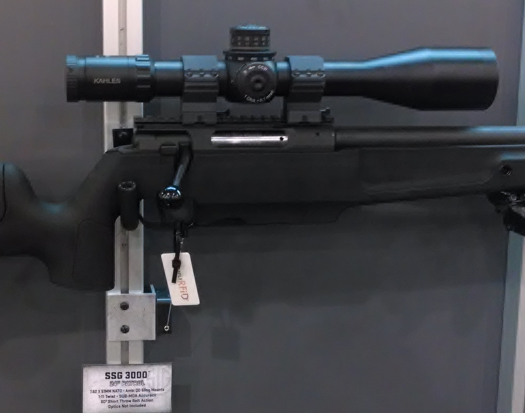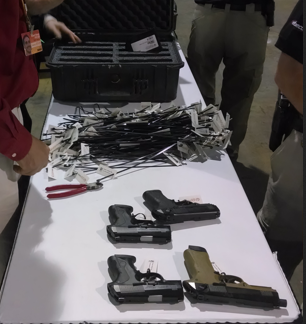RFID Used Very Effectively to Track Weapons During Annual Show
 RFID played an important role at an annual International Association of Chiefs of Police (or IACP) Conference held in Philadelphia, PA. The Conference took place over three days during October of 2013. With a reputation of providing an impressive display of the newest and coolest products and services, The IACP Conference is always eagerly anticipated by the law enforcement community.
RFID played an important role at an annual International Association of Chiefs of Police (or IACP) Conference held in Philadelphia, PA. The Conference took place over three days during October of 2013. With a reputation of providing an impressive display of the newest and coolest products and services, The IACP Conference is always eagerly anticipated by the law enforcement community.
The gun displays often generate a good portion of the excitement. Some of the most impressive booths were from the leaders in the industry such as Sig Sauer, Glock, and Colt Defense among many others. Many of these vendors had 60+ guns on display. Their booths were often crowded with excited conference attendees looking to check out the hottest new guns on the market.
For the security of the attendees, exhibitors, and staff the IACP required that all vendor weapons be registered and stored in the conference armory during all non-show hours. Each year the host city’s Police Department was responsible for regulating this process and protecting the armory. This meant that every morning all of the gun vendors would have to go to the armory to check-out their weapons. Then, every evening they would have to go through a similar process to check all of their items back into the armory. In previous years, the armory officers would print out a list of each vendor’s weapons and then manually verify each gun by serial number. The process often took hours. Vendors would be standing in a long line waiting for their turn. It seemed like an inevitable process that was frustrating for all parties involved.
During the 2012 Conference in San Diego, SimplyRFiD’s President, Carl Brown was introduced to Captain Mark Fisher of the Philadelphia Police Department. Philadelphia was set to host next year’s show and Captain Fisher was in search of something to improve the entire armory check-in/check-out process. He needed it to be easier for his team and most importantly he wanted to make sure everyone enjoyed the conference next year, especially those frustrated vendors. Luckily, Carl was just the man Captain Fisher needed to speak to.
Fast forward a year. SimplyRFiD is at the IACP armory in Philadelphia prepared with the solution. All they brought were 1000 RFID hang tags, 2 RFID Handheld Readers, 1 barcode scanner, and a laptop and printer.
The day before the show all vendors were required to come to the armory to register their weapons. Each weapon was evaluated by a Philadelphia Police officer to ensure all firing pins were removed and that it was safe for display. SimplyRFiD then tagged each gun with a small but visible RFID hang tag called the TH-3. The tag was then scanned with a barcode scanner and inputted into the software on the laptop. Once all weapons were scanned a report was generated, printed out, and then signed by the vendor.
Once everything was tagged, the rest was easy. At the end of the day each vendor came back to the armory to check their weapons in for the night. Using RFID technology, all the tagged weapons could now be read in seconds without the vendor even needing to open their cases.
SimplyRFiD’s NOXVault handheld RFID reader was able to read all the tags in just a couple pulls of the trigger. All SimplyRFiD had to do was load a simple spreadsheet all of the tagged weapon information into the NOXVault and they were good to go for the entire show. As each vendor approached, their name was selected on the Vault which prompted it to search only for that particular vendor’s weapons. Because RFID doesn’t require a direct line of sight, the weapons could be read from several feet away right through the casing. To the vendor’s amazement, hundreds of tags could be read in just a couple of seconds.
If a particular item could not be found while scanning, the handheld would specify exactly what item was missing. On occasion vendors would choose not to check in one or more of their guns overnight. In this case that particular weapon would be immediately identified and labeled as “Missing” by the handheld. This allowed the armory staff to cross verify with the vendor as to which items would be checked-in and what items would be omitted for the night. An adjustment would be made in the system and the vendor would sign for that weapon’s release.
| Click on the above image to watch the video |
What once took up to two hours (and was required to be done twice a day during a 3-day show) could now be completed in less than 20 minutes. An average vendor was checked in or out in less than 2 minutes. The process was simply reduced to scan-find-sign. No more verifying hard-to-read serial numbers over and over for the police officers and no more waiting in line for the busy vendors.
SimplyRFiD received rave reviews from Captain Fisher and his team as well as from many of the gun vendors. The IACP was also impressed by the system and is looking to use SimplyRFiD’s system again for the 2014 show in Orlando. In addition, SimplyRFiD is currently working on a project with the Philadelphia Police Department to implement a permanent system in their Armory.
Did you enjoy this article? Click on Solutions, then RFID for other interesting content. Please be sure to let vendors know you've seen them on www.Barcode.com. Thank you.
Other articles of interest:
Big Improvements as a Result of Implementing RFID Technology - As a producer of pressure-treated wood products, Cox Industries knows the importance of tracking goods from plant to building site. The company deploys a radio-frequency identification solution that has improved its shipping order accuracy to 99 percent. The benefits don't stop there: it has also realized an increase in worker productivity by 44 percent and increased inventory turns by as much as two times.
Wireless Communication Between GPS and RFID Gets a Boost - EarthSearch has positioned itself as a leader in the real-time tracking and management space. It's flagship product, the LogiBoxx Certified Solution, has been assisting shippers with not only locating RFID-tagged inventory but providing the ability to make routing decisions in real time. The company has been closing the gap between real-time location services (RTLS) and the delivery of actionable data.
RFID Provides Two Types of Standards-Based Information - For those who think RFID barcode tags can only be used to count or track inventory, think again. A case study that included such brands as Honda, Bridgestone, Alien Technology and Ohio University revealed that RFID tags are capable of carrying information critical to manufacturing, logistics and retail all within one tag.
What is RFID and How Does it Work? - Digital data is stored in a small label (called a "tag"), which can then be retrieved through the use of a radio frequency identification (RFID) tag reader. These quirky-looking tags can be read outside the line-of-sight and transmit data through an integrated radio circuit and an antenna. Learn more about RFID tags and smart labels.
Is Nano Technology the Next Leap for RFID? - RFID tags will be much smaller in the future; in fact, they may appear invisible to the naked eye. A collaboration between a group of researchers at Rice University in Texas and a team from Sunchon National University in Korea has created a nano RFID-enabled printable tag that can be embedded in almost any product or good.
RFID Improves Point-of-Sale for American Apparel (VIDEO) - One of America's leading apparel retailers has adopted RFID for its point-of-sale displays. The technology is proving to be a strong asset to better manage inventory, expedite sales and improve overall productivity in its retail stores.
Bar codes and RFID Tags Help Nuclear Plants Comply With Regulations - Authorizing worker access is a tremendous security issue for nuclear power plants. The Nuclear Regulatory Commission requires strict access controls, and RFID tags and bar codes provide a customizable identification verification solution. Using RFID and bar codes helps comply with NRC regulations and enables plant managers to monitor staff movement.
Ski Lift Scammers Thwarted by RFID Smart Chip Technology - The Vail Resort in Colorado has seen its share of fraudulent ticket holders. Now, RFID "smart chips" allow the resort to catch scammers and move lines along quicker. Skiers can move through lift gates without showing a pass, but the RFID chips enable staff to detect which skiers have paid and which ones are fraudulent.
RFID Tags Help Reduce Hotel Shrinkage - Linens are one of the highest occupancy costs for hotels and resorts. When linens disappear, which is considered "shrinkage" by the industry, properties experience lower margins. RFID to the rescue. Now they have an tool in embedded RFID tags that can withstand commercial washing, drying and pressing.
